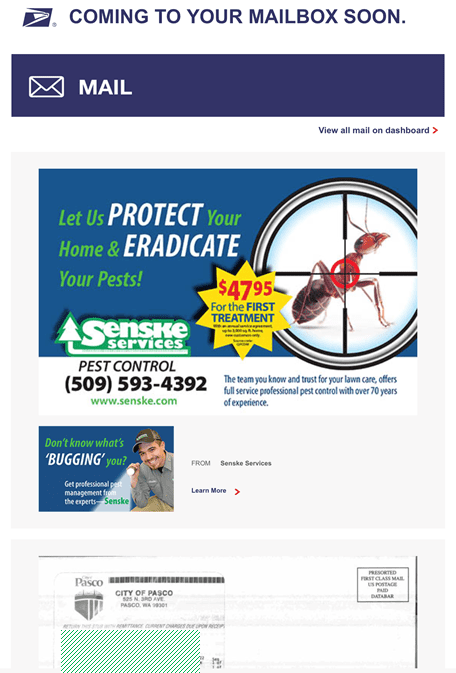
There are many marketing methods out there that your business can take advantage of, but sometimes it can be more effective to focus in on your current options and hone their performance. Below are three tools that can help you make the most out of your current marketing strategies.
Informed Delivery
If you currently use direct mailing campaigns, utilizing Informed Delivery by the U.S. Postal Service can help with your conversion rate.
Informed Delivery is a free notification service that allows consumers to digitally preview their letter-sized mailpieces and manage their packages that are scheduled to arrive soon. The postal service also allows business mailers the opportunity to engage with users through an integrated mail and digital marketing campaign.

Photo: Senske Services
While typical direct mailing campaigns would appear as greyscale scanned images to a consumer, business mailers can use Informed Delivery to connect an interactive, colorful digital ad to their direct mailer. The service is free to advertisers.
Becca Presley, director of marketing & communications for Senske Services, based in Kennewick, Washington, first heard about the service in the fall of 2018 at a marketing conference and signed up as a consumer that day.
“At that time, there were only about 12 million users nationwide,” Presley says. “Now they have over 30 million postal customer users.”
Senske Services’ typical direct mail campaign in 2020 was 630,000 pieces. The company also used Informed Delivery for smaller customer-direct campaigns. In 2020, they loaded 2.2 million pieces into the Informed Delivery system and Presley predicts they will load close to 3 million pieces for 2021.
“We’ve noticed an uptick in conversion rate for Informed Delivery versus standard email marketing,” Presley says. “For one campaign, we had a 34 percent conversion rate with the Informed Delivery ad compared to a 27 percent conversion rate for email marketing when promoting the same service.”
Since using Informed Delivery, Presley says they’ve learned to work with their designer to place the important information such as the offer on the front side of the mailer. She also advises linking the digital ads to relevant lead forms, rather than just your home page.
“Another best practice is to track your results,” Presley says. “We use Bitly short-codes to track clicks tied to the ads. The USPS also provides post-campaign results, but those are only available on their site for 30 days, so be sure to download results before they disappear.”
Presley encourages others who use direct mailing campaigns to jump in with Informed Delivery.
“I hesitated moving forward with the program because I feared it was a large time commitment,” she says. “It’s not. It takes just a few minutes to load a campaign. There was a learning curve, so getting started took a little research and set up, but the team at USPS was really helpful and easy to work with. The number one reason to use the service is that it’s free. You can improve your direct mail results with no added cost.”
Social Media Scheduling Platforms
While almost every company has social media accounts, this doesn’t mean you have the time to post regularly. Social media scheduling tools such as Hootsuite and Buffer can help with this.
“Scheduling regular content is very important to keep followers engaged with your company,” says Caitlin Clineff, recruiting specialist and company ambassador for Myatt Landscaping, based in Fuquay-Varina, North Carolina. “The more posts your followers engage with, the more they will show up in their newsfeeds. If you only post once in a while, people are less likely to see it.
For the case of Myatt Landscaping, they opted to use Buffer for their scheduling needs.
“I ended up using Buffer because it was recommended to me by a friend who works in graphic design,” Clineff says. “I kept using it because it was very user-friendly, free for the level we are using currently, and it supports posting to Instagram, which some other scheduling services don’t.”
The company shares all of their social media posts through Buffer including their holiday posts, photos of their work and employee promotions. They also share when someone has earned a new certification, links to their blog posts, links to articles that may be of interest to their followers and more.
“We use social media mainly as a tool to engage with potential and current clients and employees,” Clineff says. “We don’t do any ‘marketing’ posts, like offering special deals or encouraging people to contact us for quotes, we just try to share about our company so people can see a little bit behind the scenes and get to know us.”
If you are looking for a social media scheduling platform, Clineff suggests making sure it integrates with the platforms you’re wanting to use, that it fits your budget or if there is a free version that meets your needs. Also, determine if it will actually save you time.
“If you only use Facebook or Instagram, it may be faster to post directly to those sites, but if you’re using multiple platforms or sharing a lot of content, you may save a lot of time by using a scheduling platform,” she says.
Customer Referrals
Almost every business benefits from word of mouth, but you can take that one step further by incentivizing it. Customer referral programs are definitely not something new, but it may be something you haven’t really considered implementing.
Mark Borst, LIC, president and owner of Borst Landscape & Design based in Allendale, New Jersey, says he started his customer referral program around 8 years ago. He prefers rewarding his existing clients who are loyal rather than giving new customers free services.
When he first started the program, existing customers would receive a $250 credit for referring a new client to the company. Now over the past three years, he’s split that amount, so the existing client receives a $125 credit and the new customer receives $125 as well. Borst says they get more referrals when they remind clients about the program through e-blasts.
“I would say it definitely has boosted new sign-ons and the referrals that we get from our existing clients are really solid referrals,” Borst says.
In one instance, a client who was a restaurant owner referred so many new clients that he was able to get his services covered for a year. The company has no limit as to how many times an existing customer can refer new business.
“I would say the drawbacks that I’ve seen is that the people that are shopping just for numbers take advantage of the credit for the first year,” Borst says. “They will then go work with someone else next year so sometimes it’s a one-and-done thing.”
If you are considering adding a customer referral program, Borst says to think about what you’re doing for your existing clients.
“Maybe cash isn’t the driver,” Borst says. “Maybe it’s something else that you can come up with. We just chose it to be a credit on the account. We felt that would be the simplest way to manage it and get a thank you to them quickly.”
This article was published in the March/April issue of the magazine.

